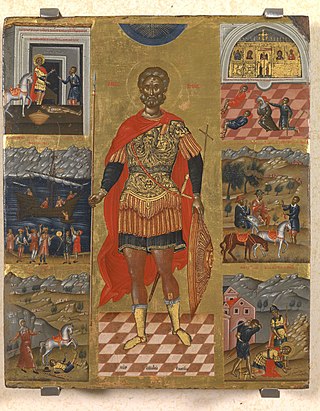
Cretan School describes an important school of icon painting, under the umbrella of post-Byzantine art, which flourished while Crete was under Venetian rule during the late Middle Ages, reaching its climax after the Fall of Constantinople, becoming the central force in Greek painting during the 15th, 16th and 17th centuries. The Cretan artists developed a particular style of painting under the influence of both Eastern and Western artistic traditions and movements; the most famous product of the school, El Greco, was the most successful of the many artists who tried to build a career in Western Europe, and also the one who left the Byzantine style farthest behind him in his later career.
The decade of the 1460s in art involved some significant events.

Angelos Pitzamanos (1467–1535) was a Greek Renaissance painter. The artists is sometimes referred to as Angelos Bitzamanos. He was born in Crete and migrated to Otranto, Southern Italy where he did most of his work. A contract between Andreas Pavias and Pitzamanos illustrates that Pitzamanos was his apprentice. Angelos was a student of Andreas Pavias for five years (1482-1487). It is evident that his work featured both the Greek style and Italian style of the time. Pitzamanos later became a famous master.

Angelos Akotantos was a Greek painter, educator, and protopsaltis. He painted icons in the maniera greca, at a time when that style was moving away from the traditions of the Byzantine Empire and towards the more refined aesthetic of the Cretan School. Akotantos taught painting to Andreas Pavias, Andreas Ritzos, and Antonios Papadopoulos, and his style influenced later artists such as Georgios Klontzas, Theophanes the Cretan, Michael Damaskinos and El Greco. Angelos's brother Ioannis was also a famous painter. There are 50 extant paintings reliably attributed to Akotantos, 30 of which bear his signature.

Andreas Ritzos also known as (Rico, Ricio, Rizo). He was a Greek icon painter, from Crete. Ritzos is considered one of the founding fathers of the Cretan School. He was affiliated with Angelos Akotantos. Most of his work stylistically follows the traditional maniera greca. His children, grandchildren, and great-grandchildren were also painters. He was one of the most influential painters of the Cretan School along with Andreas Pavias and Angelos Akotantos. He influenced the works of Georgios Klontzas, Nikolaos Tzafouris, Theophanes the Cretan, Michael Damaskinos and El Greco. According to the Institute for Neohellenic Research, sixty of his paintings have survived.

Nikolaos Tzafouris(Greek: Νικόλαος Ζαφούρης η Τζαφούρης) 1468-1501), also Niccolo, Niccolò, Niccolö, Zafuri, Zafuris, was a Greek Renaissance painter. He was one of the founders of the Cretan School. He was influenced by Angelos Akotantos. His works influenced Emmanuel Tzanes, Elias Moskos, Georgios Klontzas and Theodoros Poulakis. Tzafouris was one of the most respected artists in Crete. His most notable work is Madre della Consolazione. The painting exhibits a combination of Byzantine and Italian styles. Another notable painter in Crete around the same time was Andreas Pavias. According to the Institute of Neohellenic Research, thirteen paintings are attributed to Tzafouris.

Madre della Consolazione is a tempera painting created by Greek painter Nikolaos Tzafouris. Tzafouris was active during the second half of the 15th century. He was a prominent member of the Cretan School. He was influenced by Angelos Akotantos. The painter was exposed to works of Giovanni Bellini. At some point, he traveled to Venice and studied painting in the city. He is considered one of the most important painters because he introduced two prototypes that were mass produced by Cretan workshops. The painter is attributed with starting the specific style on the island of Crete. Most historians refer to the style as the Italian style Madonna in comparison to its Greek counterparts. Madre della Consolazione is very important because it served as a prototype for workshops on the island and it was heavily copied. Famous Greek painter Nikolaos Gripiotis and his contemporaries mass-produced the prototype. It is very difficult to attribute unsigned works because the prototype was mass-produced.

Italo-Byzantine is a style term in art history, mostly used for medieval paintings produced in Italy under heavy influence from Byzantine art. It initially covers religious paintings copying or imitating the standard Byzantine icon types, but painted by artists without a training in Byzantine techniques. These are versions of Byzantine icons, most of the Madonna and Child, but also of other subjects; essentially they introduced the relatively small portable painting with a frame to Western Europe. Very often they are on a gold ground. It was the dominant style in Italian painting until the end of the 13th century, when Cimabue and Giotto began to take Italian, or at least Florentine, painting into new territory. But the style continued until the 15th century and beyond in some areas and contexts.
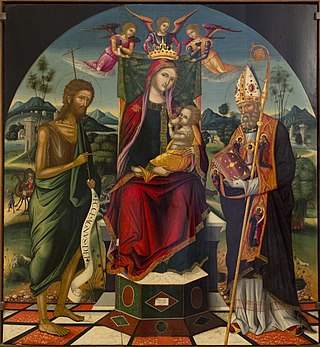
Ioannis Permeniates also known as Giovanni Permeniate, Joannes Permeniates and, Zuan Permeniatis. He was a Greek painter in Venice active during the early 16th century. His most popular painting is The Virgin and Child Enthroned. He was a Greek icon painter who attempted to escape the maniera greca. His icons exhibit qualities of both Venetian and Cretan styles. Exhibiting a more refined maniera greca, he eschews the simplicity of Duccio and Cimabue, and adds more space to his paintings.
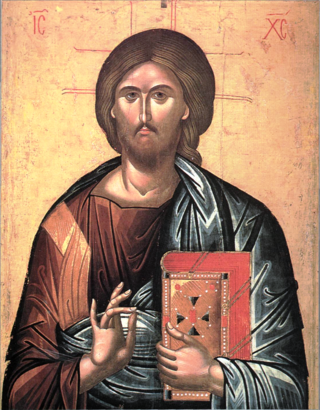
Euphrosynos was a Greek Renaissance painter. He was a priest and influenced by Byzantine art and the early Cretan School. Five of his works have survived, all of them are in Greece. His technique resembled the works of Andreas Pavias, Angelos Akotantos, and Andreas Ritzos. Euphrosynos may have been a member of the prominent Klontzas family. His paintings of the Virgin Mary and Jesus are typical Cretan School paintings. His Jesus painting resembles Pavias's painting Christ Pantocrator. All of his works are at Mount Athos in the Dionysiou Monastery. They decorate the iconostasis. Fragkos Katelanos and Theophanes the Cretan were also working at Mount Athos around the same period.

Georgios Kalliergis or Kallergis was a Byzantine Greek painter. He is one of the few Greek painters of the Byzantine empire known by name. Other Byzantine painters include: Theodore Apsevdis, Kokkinobaphos Master, and Ioannis Pagomenos. Kalliergis was one of the masters of Thessaloniki. He was part of the Macedonian School of painting. His last name Kallergis was associated with a noble family from the island of Crete. Two other very famous Greek painters Nikolaos Kallergis and Christodoulos Kalergis shared the same last name. Georgios was associated with Mount Athos, Veria, and Thessaloniki. His most notable frescos are in the Church of the Resurrection of Christ in Veria, Greece.
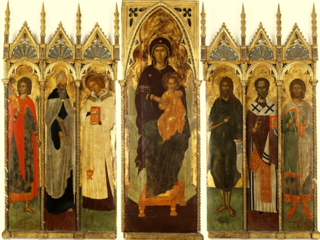
Nikolaos Philanthropinos, also known as Nicolaos Philanthropenos and Nicolaus Filantropinó or Philastropino. He was a Greek Byzantine painter. He was active in Crete, Venice, and Constantinople. He was a very famous painter during the onset of the Italian Renaissance, the end of the Palaeologan Renaissance and the beginning of the Greek Renaissance. He worked with Venetian master Nicolaus Storlado. His contemporaries in Crete were Manuel Fokas and Ioannis Pagomenos. He brought the art of Constantinople to Venice and Crete. He influenced both Greek and Italian art. Artists he influenced include: Angelos Akotantos and Andreas Ritzos. He completed some mosaics for St Mark's Basilica in Venice.
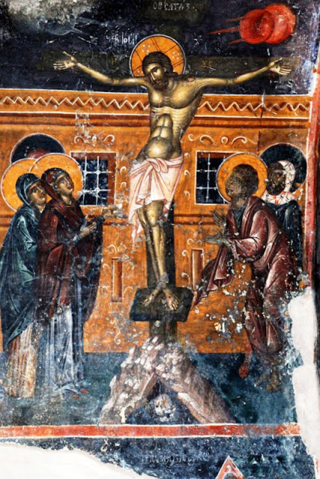
Manuel Fokas, also known as Manuele Fuca. He was a Greek Byzantine painter. He was a member of an important Greek Byzantine family. His family consisted of many painters in Crete. They flourished during the 15th and 16th century. Most of his frescos have survived until today. Other Greek-Byzantine painters included: Georgios Kalliergis, Ioannis Pagomenos, and Theodore Apsevdis. Another very important painter active around the same period in Crete was Nikolaos Philanthropinos. Three churches in Crete containing Fokas's frescos are Saint George, Emparaso, Agios Konstantinos Avdou, and Saint George Apano Symi. He influenced countless artists both Greek and Italian. Notable artists from Heraklion that his work influenced include: El Greco, Georgios Klontzas and Michael Damaskinos.

Michele Greco da Valona was a 15th/16th-century painter from Vlorë, in modern-day southern Albania. Michele represented the Adriatic renaissance. His art was similar to the style of Nicolaus Filantropinó, Fra Angelico, Paolo Uccello, Carlo Crivelli and Vincenzo de Rogata. Several of his works have survived, most notable of which is a controversial triptych featuring the Virgin Mary breastfeeding the people.

The Virgin Eleousa is a tempera painting attributed to Angelos Akotantos. Angelos Akotantos was a Greek painter active on the island of Crete during the first half of the 15th century. He is considered one of the founding members of the Cretan School along with Andreas Pavias, Andreas Ritzos, and Nikolaos Tzafouris. Over fifty paintings are attributed to Angelos Akotantos. His works served as a prototype for Greek paintings for over five hundred years. Angelos Akotantos was active in Heraklion. He was very wealthy. Much of the information about his life was drawn from a will written in 1436. Historians consider him to have been active between 1425 and 1457. Angelos Akotantos completed many icons of the Virgin and Child in the Eleousa position.
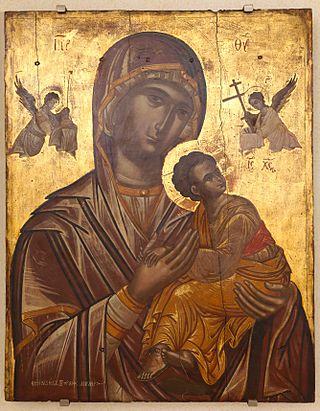
The Virgin of the Passion is a famous rendition of the Madonna and Child by Greek painter Emmanuel Tzanfournaris. He was born in Corfu to the painter Georgios Tzanfournaris. By age twenty-nine Emmanuel moved to Venice. Emmanuel's teacher was painter Thomas Bathas. He met him on the island Corfu. Bathas left Emmanuel a sizable fortune in his will. Both painters created a famous version of the Virgin and Child. The Bathas version is called Virgin Nikopoios.
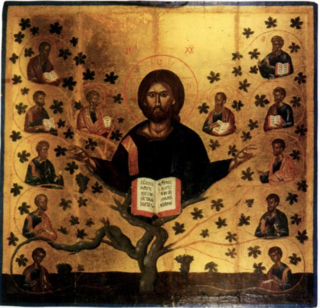
Christ the Vine is a tempera painting created by Greek painter Angelos. Angelos was active from 1425 to 1457. He was a teacher and protopsaltis. His students included some of the most famous painters of the early Cretan Renaissance. Andreas Pavias and Andreas Ritzos were his students and were heavily influenced by his style. Forty-nine of his works survived. Angelo’s Christ the Vine was one of his most important works.
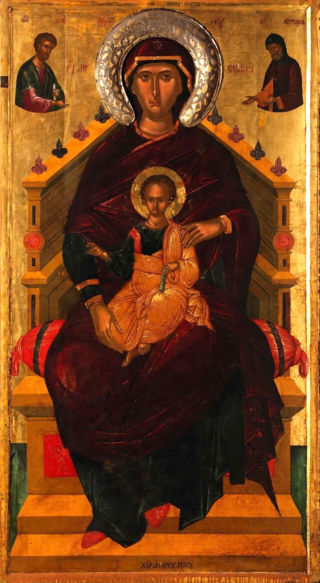
The Virgin Pantanassa is a tempera painting by Andreas Ritzos. Ritzos was a Greek painter active on the island of Crete. He flourished from 1435 to 1492. The painter has an existing catalog of over sixty works attributed to him. He signed his works in both Greek and Latin. He is one of the most influential painters of the Cretan Renaissance. He painted in the traditional Greek-Italian Byzantine style. His work was also heavily influenced by Venetian painting. His teacher was Angelos Akotantos. He was also affiliated with Andreas Pavias. His son was famous Greek painter Nikolaos Ritzos. Ritzo's Italian contemporaries were Paolo Uccello and Fra Angelico. They all painted a mixture of the Greek-Italian Byzantine and Italian Renaissance styles. The art of Crete was heavily influenced by the founder of the Venetian school Paolo Veneziano.

The Holy Towel is a tempera painting completed by Emmanuel Tzanes. He was a representative of the Late Cretan School and the Heptanese School. His one brother was famous painter and poet Marinos Tzanes. His other brother was famous painter Konstantinos Tzanes. One hundred thirty works of art are attributed to Emmanuel. He is one of the most important Greek painters of the 17th century along with Theodoros Poulakis. He was from Rethymno Crete. He was active from 1625 to 1690. He painted for over sixty-five years. He was the priest of San Giorgio dei Greci in Venice for thirty years.

The Holy Family is an oil painting created by Greek painter Panagiotis Doxaras. He was a prominent member of the Heptanese School. He was also an author. His son Nikolaos Doxaras was also a famous painter. Panayiotis was from a small village named Koutifari, close to Kalamata. He moved to Zakynthos at a young age. He studied painting with famous painter Leos Moskos. He traveled all over the Venetian empire with the famous artist including Venice. He studied painting in Venice for five years. He became a theoretical painter. He wrote several books on painting. He traveled all over the Ionian Islands. He lived in Lefkada, Zakynthos, and Corfu. He frescoed the ceiling of Panagia Faniromeni in Zakynthos. Eighteen of his paintings survived.


















